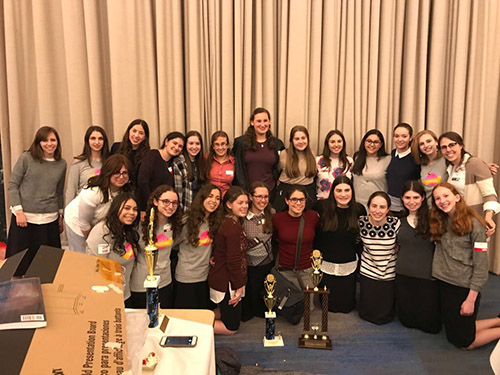

Bruriah continues to demonstrate unparalleled excellence in STEM as they placed first from all schools with 1-10 teams in the CIJE Innovation Day competition at the New York Hilton this past Sunday.
Bruriah placed second overall among thirty-nine schools participating in the competition, right behind Frisch.
These latest wins come at the heels of two other major STEM victories for Bruriah students—the recent collegiate-level women’s Hackathon sponsored by Touro College during which Bruriah students took first place, and the Weizmann Institute’s prestigious international STEM competition, in which a team of Bruriah students rigorously competed against teams hand-picked from around the world.
Sunday’s silver winning team was comprised of two teams who worked independently to create a system for vision-impaired individuals.
Group A, led by students Chana Rosenbluth and Brocha Silverman created “The Eye Opener,” which is a wearable device that allows blind individuals to be walking-stick independent. Functionally, their device can detect objects in the environment. It calculates the distance of objects from the sight-impaired individual and determines if the object is too long or too high to step over. The device can also detect items that are at eye level, which are traditionally not “visible” by walking sticks. The device then sends a signal out to notify the blind individual how to maneuver based upon the data it obtains. This allows blind individuals to get a schematic of their environment.
Group B developed a sister project, led by Rachelli Benoff, Adina Schwartz and Ahuva Strauss, who created “Good Vibes,” a project designed to display to blind individuals a map of the world based upon touch. The group designed an armband wearable device that contained vibrating motors. Each of the motors was strategically placed to indicate a position within physical space in front of the blind person. When an object is detected in an individual’s “sight,” the vibration motor on the band corresponding to the object’s position in space is triggered to vibrate. The frequency of the vibration itself also displays to the wearer the distance of that object. The group also incorporated additional motors that vibrate and send signals to the blind individual to tell them when to step around or over the item they are about to encounter. During the construction of their project, students used simulated numbers to approximate this information.
When both groups completed their projects, they were excited to discover the functional compatibility between them and opted to wire the two together so that Group A’s wearable sensors data transmitted to Group B’s wearable vibration system. This step functionally replaced Group B’s simulated data with a real life map of the physical environment.
The groups then presented their device to judges together, as one functional unit under the banner theme of moving from dark to light.
This is not the first time that Bruriah or RTMA students have engineered functional devices with real-world applications, and both divisions currently have a number of items set for further commercial development.










